2025-06-20 Fri
■ #5898. 英語史研究において「コーパスを用いる」ことの難しさ [corpus][historical_linguistics][speech][writing][methodology][register]
標題は,定期的に戻って考えておく必要のある問題である.先日も大学院の授業にて関連する議論が展開したので,ここで改めて検討しておきたい.
近年,英語史研究においてコーパスを用いることは,当たり前の手法となっている.現代英語ほどではないが,過去の英語においてもそれなりの規模のテキストデータにアクセスできるようになったことで,過去の言語現象を客観的かつ定量的に分析することが可能となり,多くの画期的な知見がもたらされている.
しかし,コーパスに基づく英語史研究の隆盛は,ある違和感を生み出してもいる.それは,データがあるものしか語られないし,語れない,という問題だ.歴史コーパスは,現存する書かれたテキストから構成される.これは,古英語から中英語を経て初期近代英語期までの言語資料は,書き言葉でしか残されていないという絶対的な制約がある以上,致し方のないことではある.歴史英語の大半は,原則として話し言葉ではなく書き言葉の情報しか与えてくれないのだ.
しかし,この制約は,古い英語に専門的に接していればいるほど,忘れられやすいものでもある.歴史コーパスには,あたかも当時の英語全体が,すなわち書き言葉の背後にあると仮定される話し言葉をも含めた英語資料が収められているかのような錯覚に陥りやすいのだ.実際には,コーパスのなかには,話し言葉は,少なくとも直接的には収められていないにもかかわらずだ.同様に,書き言葉に付されにくいジャンルの言語使用や,社会的に周縁化された人々の言語資料も,コーパスに含まれてないことが多い.コーパスを用いても,書かれなかったレジスターの英語の歴史にはアクセスできないのだ.コーパスを常用する英語史研究者は,書かれなかったものの歴史を語ることの難しさ,そしてその重要性を意識しておく必要がある.
このように議論するのは,コーパスの限界をネガティヴに指摘して終わるためではない.むしろコーパスを補完する他の視点をもつことの重要性を強調するためである. 言語学的素養,文献学的知識,社会的背景の理解などを組み合わせることで,コーパスデータだけでは見えてこない言語の歴史に光を当てようとすることが肝要である.
関連して,以下の記事も参照.
・ 「#307. コーパス利用の注意点」 ([2010-02-28-1])
・ 「#367. コーパス利用の注意点 (2)」 ([2010-04-29-1])
・ 「#428. The Brown family of corpora の利用上の注意」 ([2010-06-29-1])
・ 「#1280. コーパスの代表性」 ([2012-10-28-1])
・ 「#2584. 歴史英語コーパスの代表性」 ([2016-05-24-1])
・ 「#2779. コーパスは英語史研究に使えるけれども」 ([2016-12-05-1])
・ 「#3967. コーパス利用の注意点 (3)」 ([2020-03-07-1])
・ 「#4915. 英語史のデジタル資料 --- 大学院のデジタル・ヒューマニティーズ入門講義より」 ([2022-10-11-1])
・ 「#4916. デジタル資料を用いた研究の功罪について議論しました」 ([2022-10-12-1])
・ 「#5280. 本年度も大学院生とデジタル資料を用いた研究の功罪について議論しました」 ([2023-10-11-1])
2025-01-24 Fri
■ #5751. 堀公俊(著)『アイデア発想フレームワーク』(日本経済新聞出版社,2014年) [review][methodology][toc]
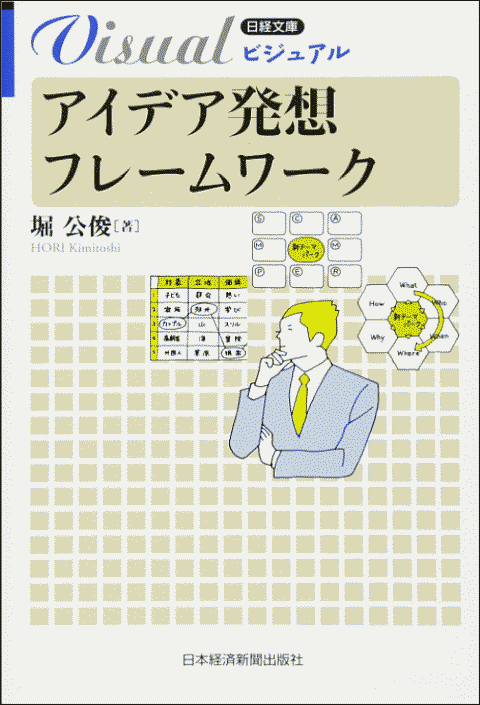
「#5647. 『思考法図鑑』(株式会社アンド,翔泳社,2019年)」 ([2025-01-20-1]) および「#5650. 『ビジネスフレームワーク図鑑』(株式会社アンド,翔泳社,2018年)」 ([2025-01-23-1]) に引き続き,発想法に関する書籍を紹介する.
手軽な文庫サイズだが,68項目170種類の「アイデア発想に役立つフレームワーク(原理・モデル・視点といった考え方の枠組み)」 (p. 4) がぎっしり詰め込まれている.以下,目次を示す.
第I章 情報収集のフレームワーク
1 カラーバス
2 変化と兆し
3 共感図法
4 ロールプレイング
5 フィールド・インタビュー
6 グループ・インタビュー
7 ブラウジング
8 コンテクストマップ
9 タイムライン
10 リッチピクチャー
11 ビジネスモデル分析
Coffee Break ドリームチームをつくれば強くなる?
第II章 自由発想のフレームワーク
12 ブレーンストーミング
13 ブレーンライティング
14 アンチプロブレム
15 ゴー・ストップ法
16 フィリップス66法
17 マインドマップ
18 マンダラート
19 仮想ストーリー
20 ピクチャーカード
21 モノ語り
22 ワールドカフェ
23 オープン・スペース・テクノロジー
Coffee Break 発想を妨げているものは何?
第III章 視点転換のフレームワーク
24 オズボーンのチェックリスト
25 6つの帽子
26 5W1H
27 刺激ワード法
28 ワードダイヤモンド
29 カタルタ
30 加減乗除
31 マトリクス法
32 逆設定法
33 アズ・イフ
34 アイスブレイク
35 リフレーミング
36 ポジティブ・アプローチ
37 質問会議
Coffee Break 三人寄れば文殊の知恵が出るか?
第IV章 発想支援のフレームワーク
38 KJ法
39 セブンクロス
40 欠点列挙法
41 属性列挙法
42 形態分析法
43 シネクティクス法
44 NM法
45 バリュー・エンジニアリング
46 バリューグラフ
47 TOC
48 因果ループ図
49 TRIZ(トゥリーズ)
50 KT法
51 フューチャーサーチ
Coffee Break 不透明な未来を見通すには?
第V章 試作検証のフレームワーク
52 モデリング
53 コラージュ
54 メタファ
55 イメージカタログ
56 カバーストーリー
57 ストーリーテリング
58 スキット
59 インプロ
60 シナリオプランニング
61 ギャラリーウォーク
Coffee Break 最強のフレームワークはどれ?
第IV章 評価決定のフレームワーク
62 ドット投票
63 PMI法
64 SUCCESs
65 ハイ・ロー・マトリクス
66 星取り表
67 Who/What/When
68 満足度マトリクス
索 引
主な参考文献
発想フレームワークお薦め本
使えるビジネス・フレームワーク69
目移りするほどだが,実は名前を知らずとも,誰しもが普段使いしているフレームワークがここにたくさん含まれている.このことを意識するだけで,すでに発想法の世界に足を踏み入れているともいえる.
・ 堀 公俊 『アイデア発想フレームワーク』 日本経済新聞出版社,2014年.
[ 固定リンク | 印刷用ページ ]
2025-01-23 Thu
■ #5750. 『ビジネスフレームワーク図鑑』(株式会社アンド,翔泳社,2018年) [review][methodology][toc]
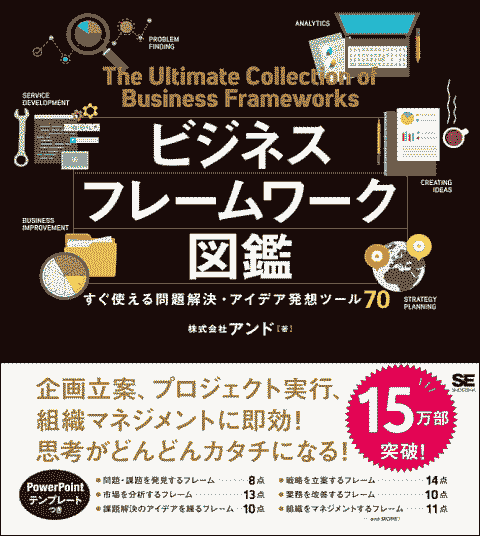
3日前の記事「#5647. 『思考法図鑑』(株式会社アンド,翔泳社,2019年)」 ([2025-01-20-1]) に引き続き,研究のための思考法としても役立つビジネスフレームワークの本を紹介しよう.同じ出版元だが,実は今回取り上げる書籍のほうが1年早く出版されている.目次がそのままフレームワークの名前になっている.
序章 フレームワークを活用するために
第1章 問題・課題を発見する
STEP1 問題をあぶり出す
-01 As is/To be
-02 6W2H
-03 なぜなぜ分析
-04 コントロール可能/不可能
STEP2 問題を整理する
-05 ロジックツリー
-06 課題設定シート
STEP3 優先順位の決定
-07 緊急度/重要度マトリクス
-08 意思決定マトリクス
コラム 他責と自責のどちらで考えるか
第2章 市場を分析する
STEP1 マクロ環境や自社について分析する
-09 PEST分析
-10 ファイブフォース分析
-11 VRIO分析
-12 SWOT分析
STEP2 顧客について分析する
-13 パレート分析
-14 RFM分析
-15 ペルソナ
-16 共感マップ
-17 カスタマージャーニーマップ
STEP3 競合について分析する
-18 4P分析
-19 4P+誰に何を分析
-20 バリューチェーン分析
-21 コア・コンピタンス分析
コラム 定量・定性の違いをきちんと知っておこう
第3章 課題解決のためのアイデアを練る
STEP1 制限なくアイデアを発想する
-22 ブレインライティング
-23 マンダラート
-24 形態分析法
-25 シナリオグラフ
-26 オズボーンのチェックリスト
STEP2 アイデアを形にしてみる
-27 アイデアシート
-28 ストーリーボード
STEP3 アイデアの評価と選択
-29 プロコン表
-30 SUCCESs
-31 ペイオフマトリクス
コラム アイデア発想や評価の場面では「バイアス」に気を付けよう
第4章 戦略を立案する
STEP1 戦略の方向性を考える
-32 プロダクト・ポートフォリオ・マネジメント
-33 アンゾフの成長マトリクス
-34 クロスSWOT
-35 STP
-36 ポジショニングマップ
STEP2 どのように実現するかを考える
-37 ビジネスモデル・キャンバス
-38 スキーム図
-39 AIDMA
-40 ガントチャート
-41 組織図
STEP3 目標を設定する
-42 ロードマップ
-43 KPIツリー
-44 AARRR
-45 SMART
コラム バックキャスティングとフォアキャスティング
第5章 業務を改善する
STEP1 結果を振り返る
-46 KPT
-47 YWT
-48 PDCA(チェックシート)
STEP 2 業務の状態を可視化する
-49 業務棚卸シート
-50 業務フロー図
-51 PERT図
-52 RACI
STEP3 改善策を考える
-53 ムリ・ムダ・ムラ(ダラリの法則)
-54 ECRS
-55 業務改善提案シート
コラム 会議運営を担当する場合に押さえておきたいポイント
第6章 組織をマネジメントする
STEP1 目的を共有する
-56 ミッション・ビジョン・バリュー
-57 Will/Can/Must
-58 Need/Wantマトリクス
STEP 2 メンバー間の関係性の質を高める
-59 ジョハリの窓
-60 認知/行動ループ
-61 ウォント/コミットメント
-62 PM理論
-63 ステークホルダー分析
STEP3 メンバーのモチベーションを高める
-64 動機付け・衛生理論
-65 Will/Skillマトリクス
-66 GROWモデル
コラム 会議を行う際はグランドルールを設定しておく
第7章 他者に伝える・共有する
STEP1 情報を伝える
-67 商品企画書
-68 イベント企画書
-69 PREP
-70 TAPS
巻末付録1 フレームワークの活用MAP
巻末付録2 フレームワーク活用場面の一覧表
参考文献・Webサイト
問題発見,問題解決,アイディアの拡散と発散,研究手法の開発,結果の公表等,いろいろなことに役立つ.パラパラめくって気になった手法を,今抱えている問題に適用するだけで,いつでも何か新しいことが生まれそうだ.
・ 株式会社アンド 『ビジネスフレームワーク図鑑 すぐ使える問題解決・アイデア発想ツール70』 翔泳社,2018年.
2025-01-20 Mon
■ #5747. 『思考法図鑑』(株式会社アンド,翔泳社,2019年) [review][methodology][toc]

私は研究者であり,ビジネスマンでも経営者でもないのだが,ビジネス系の思考法やフレームワークの本が好きである.問題点の同定,問題解決の方法論,アイディアの発散と収束,情報の提示の仕方など,研究にも参考になることが多いからだ.
どういうわけか,研究のための思考法一覧のような書籍はあまり出ていない.研究者は,学術研究の手法を有限個のフレームワークに押し込めるのに抵抗があるのかもしれない.とすると,この分野は,むしろビジネス系の書籍に頼る必要があるのだ.
考えてみれば,古来,広い意味での rhetoric は logic とともに知的活動の中心をなしていた.これは研究にもビジネスにも等しく資するし,生活にだって恋愛にだって役立つ可能性が高い.現代の思考法やフレームワークは,その現代版といってもよいのではないか.
お薦め本はいろいろとあるが,今回は『思考法図鑑』(株式会社アンド,翔泳社,2019年)を挙げたい.以下に目次を挙げるが,そのまま様々な思考法の一覧となっていることが分かるだろう.
序章 思考法を活用するために
第1章 思考の基礎体力を高める
01 論理的思考(ロジカル・シンキング)
02 批判的思考(クリティカル・シンキング)
03 演繹的思考
04 帰納的思考
05 アブダクション
06 要素分解
07 MECE
08 PAC思考
09 メタ思考
10 ディベート思考
第1章のエクササイズ
コラム:思考のズームインとズームアウト
第2章 アイデアの発想力を高める
11 ブレインストーミング
12 類推思考
13 水平思考
14 逆説思考
15 IF思考
16 素人思考
17 トレードオン思考
18 プラスサム思考
19 弁証法
20 ストーリー思考
21 2軸思考
22 図解思考
第2章のエクササイズ
コラム:「開く問い」と「閉じる問い」
第3章 ビジネス思考力を高める
23 価値提案思考
24 シーズ思考
25 ニーズ思考
26 デザイン思考
27 ビジネスモデル思考
28 マーケティング思考
29 戦略的思考
30 確率思考
31 逆算思考
32 オプション思考
33 ビジョナリー思考
34 コンセプチュアル思考
第3章のエクササイズ
コラム:小さく生んで大きく育てる
第4章 プロジェクトの推進力を高める
35 Why思考(目的探索)
36 改善思考
37 経験学習モデル
38 ダブル・ループ学習
39 プロセス思考
40 横断的思考
41 GTD
42 自責思考
43 ポジティブ思考
44 ABC 理論
45 内観法
46 相対的思考
47 抽象化思考
第4章のエクササイズ
コラム:「Yes, And」で考える
第5章 分析力を高める
48 仮説思考
49 論点思考
50 フレームワーク思考
51 ボトルネック分析
52 ファネル分析
53 相関分析
54 回帰分析
55 時系列分析
56 Why思考(原因分析)
57 因果関係分析
58 因果ループ
59 システム思考
60 KJ法
第5章のエクササイズ
コラム:定量・定性データと仮説検証
思考を加速させるビジネスフレームワーク一覧
参考文献・Webサイト
私も研究やその他で,いくつかの思考法を利用している.
・ 株式会社アンド 『思考法図鑑 ひらめきを生む問題解決・アイデア発送のアプローチ60』 翔泳社,2019年.
2024-09-25 Wed
■ #5630. 語源学とは何か? --- 『英語語源辞典』 (p. 1647) より [hellive2024][khelf][kdee][etymology][terminology][archaeology][history][philology][methodology][lexicology][historical_linguistics][comparative_linguistics]
一昨日の Voicy heldio にて「#1212. 『英語語源辞典』の「語源学解説」精読 --- 「英語史ライヴ2024」より」を配信しました.これは,9月8日に heldio を媒体として開催された「英語史ライヴ2024」の午前9時過ぎから生配信された精読会のアーカイヴ版です.研究社より出版されている『英語語源辞典』の巻末の専門的な解説文を,皆で精読しながら解読していこうという趣旨の読書会です.当日は多くのリスナーの方々に生配信でお聴きいただきました.ありがとうございました.
khelf の藤原郁弥さん(慶應義塾大学大学院生)が MC を務め,そこに「英語語源辞典通読ノート」で知られる lacolaco さん,およびまさにゃんこと森田真登さんが加わり,45分間の集中精読会が成立しました.ニッチな企画ですが,非常に濃い議論となっています.『英語語源辞典』のファンならずとも楽しめる配信回だと思います.ぜひお聴きください.以下は,精読対象となった文章の最初の2段落です (p. 1647) .
1. 語源学とは何か
語源学の目的は,特定言語の単語の音形(発音・綴り字)と意味の変化の過程を可能なかぎり遡ることによって,文献上または文献以前の最古の音形と意味を同定または推定し,その言語の語彙組織におけるその語の位置を通時的に決定することにある.したがって,語源学はフィロロジーの一分科あるいは語彙論に属するが,その方法論と実践とにおいて,歴史・比較言語学と密接に関連し,また歴史的考証や考古学の成果をも援用する.
英語の場合であれば,現代英語から中期英語 (Middle English: 略 ME),古期英語 (Old English: 略 OE) の段階にまで遡る語史的語源的研究と,さらに英語の成立以前に遡ってゲルマン基語 (proto-Germanic: 略 Gmc),印欧基語 (Proto-Indo-European: 略 IE) の段階を扱う遡源的語源研究とが考えられる.ある単語の語源を特定するためには,この両面を通じて,形態の連続性と同時に意味の連続性が確認されなければならない.そして,英語という言語が成立した後の語史的考察が英語成立以前の遡源的考察に先行すべきこと,すわなち英語史的研究が比較言語学的研究に先行すべきことはいうまでもないであろう.
上記配信回を受けて,私の感想です.この2段落は,実はかなり難解だと思います.2点を指摘します.1つめに「語源学の目的は〔中略〕その言語の語彙組織におけるその語の位置を通時的に決定することにある」をすんなりと理解できる読者は少ないのではないでしょうか.私自身もこの文の字面の「意味」は理解したとしても,それがどのような「意義」をもつのかを理解するには少々の時間を要しましたし,その理解が当たっているのかどうかも心許ないところです.
2つめは,最後の部分「英語という言語が成立した後の語史的考察が英語成立以前の遡源的考察に先行すべきこと,すわなち英語史的研究が比較言語学的研究に先行すべきことはいうまでもないであろう」です.この箇所については,本当にいうまでもないほど自明なのだろうか,という疑問が生じます.というのは,時間的にみる限り,語史的考察は遡源的考察に先行しないからです.それなのに「英語史的研究が比較言語学的研究に先行すべき」というのは,むしろ矛盾しているように聞こえないでしょうか.この2点目については,この後の段落を読めば,確かに真意がわかってきます.いずれにせよ,なかなかの水準の高い最初の2段落ではないでしょうか.
1点目について私は考えるところがあるのですが,皆さんも改めて「語源学の目的は〔中略〕その言語の語彙組織におけるその語の位置を通時的に決定することにある」の解釈を考えていただければと思います.
語源学とは何か? という問いについては,hellog より以下の記事を参照.
・ 「#466. 語源学は技芸か科学か」 ([2010-08-06-1])
・ 「#727. 語源学の自律性」 ([2011-04-24-1])
・ 「#1791. 語源学は技芸が科学か (2)」 ([2014-03-23-1])
・ 「#598. 英語語源学の略史 (1)」 ([2010-12-16-1])
・ 「#599. 英語語源学の略史 (2)」 ([2010-12-17-1])
ここまでのところで『英語語源辞典』に関心をもった方は,ぜひ入手していただければ.
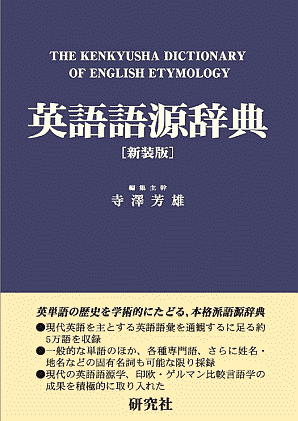
・ 寺澤 芳雄(編集主幹) 『英語語源辞典』新装版 研究社,2024年.
2024-09-18 Wed
■ #5623. 「英語史ライヴ2024」で B&C の第57節 "Chronological Criteria" を対談精読実況生中継しました [bchel][latin][borrowing][methodology][sound_change][palatalisation][loan_word][oe][chronology][lexicology][phonetics][hellive2024]
一昨日の Voicy heldio にて「#1205. Baugh and Cable 第57節を対談精読実況生中継 --- 「英語史ライヴ2024」より」をアーカイヴ配信しました.これは「#5607. 「英語史ライヴ2024」で B&C の第57節 "Chronological Criteria" を対談精読実況生中継します」 ([2024-09-02-1]) で予告したとおり,9月8日(日)に開催された「英語史ライヴ2024」の早朝枠にて生配信された番組がもとになっています.
金田拓さん(帝京科学大学)がメインMCを務め,小河舜さん(上智大学)と私が加わる形での対談精読実況生中継でした.ヘルメイト(helwa リスナー)や khelf メンバーも数名がギャラリーとして収録現場に居合わせ,生配信でお聴きになったリスナーものべ81名に達しました.たいへんな盛況ぶりです.皆さん,日曜日の朝から盛り上げてくださり,ありがとうございました.
今回取り上げたセクションは,実はテクニカルです.古英語期のラテン借用語について,それぞれの単語が同時期内でもいつ借りられたのか,いわば借用の年代測定に関する方法論が話題となっています.取り上げられているラテン借用語の例はすこぶる具体的ではありますが,音変化の性質や比較言語学の手法に光を当てる専門的な内容となっています.
しかし,今回の対談精読会にそってに丁寧に英文を読み解いていえば,必ず理解できますし,歴史言語学研究のエキサイティングな側面を体験することもできるでしょう.本編48分ほどの長尺ですが,ぜひお時間のあるときにゆっくりお聴きください.
Baugh and Cable の精読シリーズのバックナンバー一覧は「#5291. heldio の「英語史の古典的名著 Baugh and Cable を読む」シリーズが順調に進んでいます」 ([2023-10-22-1]) に掲載しています.ぜひこの機会にテキストを入手して,第1節からお聴きいただければ.
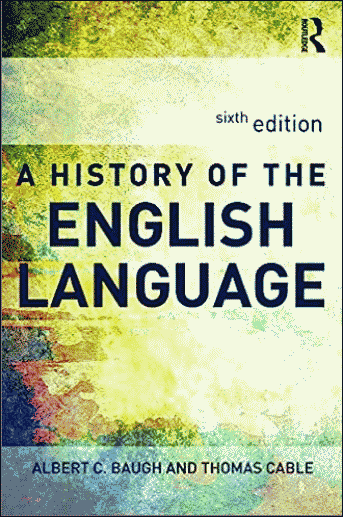
・ Baugh, Albert C. and Thomas Cable. A History of the English Language. 6th ed. London: Routledge, 2013.
2024-09-02 Mon
■ #5607. 「英語史ライヴ2024」で B&C の第57節 "Chronological Criteria" を対談精読実況生中継します [bchel][latin][borrowing][methodology][sound_change][palatalisation][loan_word][oe][chronology][lexicology][phonetics][hellive2024]

Baugh and Cable による英語史の古典的名著を Voicy heldio にて1節ずつ精読していくシリーズをゆっくりと進めています.昨年7月に開始した有料シリーズですが,たまの対談精読回などでは通常の heldio にて無料公開しています.
9月8日(日)に12時間 heldio 生配信の企画「英語史ライヴ2024」が開催されますが,当日の早朝 8:00-- 8:55 の55分枠で「Baugh and Cable 第57節を対談精読実況生中継」を無料公開する予定です.金田拓さん(帝京科学大学)と小河舜さん(上智大学)をお招きし,日曜日の朝から3人で賑やかな精読回を繰り広げていきます.
テキストをお持ちでない方のために,当日精読することになっている第57節 "Chronological Criteria" (pp. 73--75) の英文を以下に掲載しておきます.古英語期のラテン借用語の年代測定に関するエキサイティングな箇所です.じっくりと予習しておいていただけますと,対談精読実況生中継を楽しく聴くことができると思います.
57. Chronological Criteria. In order to form an accurate idea of the share that each of these three periods had in extending the resources of the English vocabulary, it is first necessary to determine as closely as possible the date at which each of the borrowed words entered the language. This is naturally somewhat difficult to do, and in the case of some words it is impossible. But in a large number of cases it is possible to assign a word to a given period with a high degree of probability and often with certainty. It will be instructive to pause for a moment to inquire how this is done.
The evidence that can be employed is of various kinds and naturally of varying value. Most obvious is the appearance of the word in literature. If a given word occurs with fair frequency in texts such as Beowulf, or the poems of Cynewulf, such occurrence indicates that the word has had time to pass into current use and that it came into English not later than the early part of the period of Christian influence. But it does not tell us how much earlier it was known in the language, because the earliest written records in English do not go back beyond the year 700. Moreover, the late appearance of a word in literature is no proof of late adoption. The word may not be the kind of word that would naturally occur very often in literary texts, and so much of Old English literature has been lost that it would be very unsafe to argue about the existence of a word on the basis of existing remains. Some words that are not found recorded before the tenth century (e.g., pīpe 'pipe', cīese 'cheese') can be assigned confidently on other grounds to the period of continental borrowing.
The character of the word sometimes gives some clue to its date. Some words are obviously learned and point to a time when the church had become well established in the island. On the other hand, the early occurrence of a word in several of the Germanic dialects points to the general circulation of the word in the Germanic territory and its probable adoption by the ancestors of the English on the continent. Testimony of this kind must of course be used with discrimination. A number of words found in Old English and in Old High German, for example, can hardly have been borrowed by either language before the Anglo-Saxons migrated to England but are due to later independent adoption under conditions more or less parallel, brought about by the introduction of Christianity into the two areas. But it can hardly be doubted that a word like copper, which is rare in Old English, was nevertheless borrowed on the continent when we find it in no fewer than six Germanic languages.
The most conclusive evidence of the date at which a word was borrowed, however, is to be found in the phonetic form of the word. The changes that take place in the sounds of a language can often be dated with some definiteness, and the presence or absence of these changes in a borrowed word constitutes an important test of age. A full account of these changes would carry us far beyond the scope of this book, but one or two examples may serve to illustrate the principle. Thus there occurred in Old English, as in most of the Germanic languages, a change known as i-umlaut. (Umlaut is a German word meaning 'alteration of sound', which in English is sometimes called mutation.) This change affected certain accented vowels and diphthongs (æ, ā, ō, ū, ēa, ēo , and īo) when they were followed in the next syllable by an ī or j. Under such circumstances, æ and a became e, and ō became ē, ā became ǣ, and ū became ȳ. The diphthongs ēa, ēo, īo became īe, later ī, ȳ. Thus *baŋkiz > benc (bench), *mūsiz > mȳs, plural of mūs (mouse), and so forth. The change occurred in English in the course of the seventh century, and when we find it taking place ina word borrowed from Latin, it indicates that the Latin word had been taken into English by that time. Thus Latin monēta (which became *munit in Prehistoric OE) > mynet (a coin, Mod. E. mint) and is an early borrowing. Another change (even earlier) that helps us to date a borrowed word is that known as palatal diphthongization. By this sound change ǣ or ē in early Old English was changed to a diphthong (ēa and īe, respectively) when preceded by certain palatal consonants (ċ, ġ, sc). OE cīese (L. cāseus, chesse) mentioned earlier, shows both i-umlaut and palatal diphthongization (cāseus > *ċǣsi > *ċēasi > *ċīese). In many words, evidence for date is furnished by the sound changes of Vulgar Latin. Thus, for example, an intervocalic p (and p in the combination pr) in the Late Latin of northern Gaul (seventh century) was modified to a sound approximating a v, and the fact that L. cuprum, coprum (copper) appears in OE as copor with the p unchanged indicates a period of borrowing prior to this change (cf. F. cuivre). Again Latin ī changed to e before A.D. 400 so that words like OE biscop (L. episcopus), disc (L. discus), sigel 'brooch' (L. sigillum), and the like, which do not show this change, were borrowed by the English on the continent. But enough has been said to indicate the method and to show that the distribution of the Latin words in Old English among the various periods at which borrowing took place rests not upon guesses, however shrewd, but upon definite facts and upon fairly reliable phonetic inferences.
Baugh and Cable の精読シリーズのバックナンバー一覧は「#5291. heldio の「英語史の古典的名著 Baugh and Cable を読む」シリーズが順調に進んでいます」 ([2023-10-22-1]) に掲載しています.ぜひこの機会にテキストを入手して,第1節からお聴きいただければ.
・ Baugh, Albert C. and Thomas Cable. A History of the English Language. 6th ed. London: Routledge, 2013.
2024-08-31 Sat
■ #5605. 「漢字列」という用語・概念 [terminology][kanji][graphology][writing][review][japanese][chinese][methodology]

「#5601. 漢字は中国語と日本語で文字論上の扱いが異なる」 ([2024-08-27-1]) の記事で,今野を引用して漢字の文字論を考えた.そのなかで「漢字列」という用語がさらっと登場した.しかし,これは日本語における漢字の役割を議論する上で,すこぶる重要な用語であり概念だと学んだ.私たちが一般的に「漢熟語」としてとらえている,典型的には漢字2字ほどからなる表現のことである.
今野は「漢字列」という洞察を導入するにあたって,具体例として「平明」を挙げている.普通に考えれば,これは「ヘイメイ」と音読みで読み下すだろう.しかし,それは現代の話しである.12世紀半ばという時代設定で考えると,この漢字2文字からなる「漢字列」は,音読みの「ヘイメイ」のみならず,訓読みで「アケホノ」とも読み下すことができた.漢語が多く使われている文章内では「ヘイメイ」と読み下す可能性が高く,和語が多く使われている文章内では「アケホノ」の可能性が高かったにちがいない.この2文字の連なりは,原理的には1つの読みに定まらなかったのであり,その点において正書法がなかった,といえるのだ.
かくして,この漢字2文字の扱いは宙ぶらりんとなる.この漢字2文字を,きわめて形式的に「漢字列」と呼んでおこう.これをどのように読み下すかは別として,読み下す以前の形式に言及したい場合に,無味乾燥な「漢字列」の呼称は意外と便利である.読み下しの結果いかんにかかわらず使える用語・概念だからだ.
ここまで来たところで,今野 (44--45) の説明を導入しよう.きっとこの用語・概念の有益さが分かるだろう.
しかし,とにもかくにも,言語を観察しようとしているのに,今みている漢字列がいかなる語をあらわしているかわからない,という状況が日本語においては起こり得る.こうしたことにかかわることがらを説明しようとした時になんとも落ち着きがわるいし,説明しにくい.その落ち着きのわるさ,説明のしにくさをいくらかでも解消するために,いかなる語をあらわしているかわからないものに「漢字列」という名前をつけておく.それがいかなる語をあらわしているか判明したら,和語とか漢語とかはっきりとした呼び方をすればよい.また語を超えた単位であっても,漢字が並んでいるものはすべて「漢字列」と呼ぶ.
このように「漢字列」という概念を設定しておくことは日本語の歴史の観察,分析,記述に有効であると考える.あるいは有効であることを超えて,「漢字列」が日本語の歴史にとってのキー・ワードの一つかもしれない.つまり,「漢字列」という概念を使って説明すると,うまく説明できることが多いのが日本語ということになる.当然のことであるが,文字化に漢字を使っていない言語について考えるにあたっては「漢字列」という概念は必要がない.表音文字のみを使う言語の観察には存在しない概念といってよい.
一般文字論にとって,きわめて示唆に富む洞察ではないか.
・ 今野 真二 『日本語と漢字 --- 正書法がない言葉の歴史』 岩波書店〈岩波新書〉,2024年.
2024-04-26 Fri
■ #5478. 中英語における職業を表わす by-name とともに現われる定冠詞や前置詞とその脱落 [article][preposition][onomastics][personal_name][name_project][methodology][eme][by-name][latin][french][evidence][translation][me_dialect][sobokunagimon][occupational_term]
英語の姓には,原則として定冠詞 the の付くものがない.また,前置詞 of を含む名前もほとんどない.この点で,他のいくつかのヨーロッパ諸語とは異なった振る舞いを示す.
しかし歴史を振り返ると,中英語期には,職業名などの一般名詞に由来する姓は一般名詞として用いられていた頃からの惰性で定冠詞が付く例も皆無ではなかったし,of などの前置詞付きの名前なども普通にあった.中英語期の姓は,しばしばフランス語の姓の慣用に従ったこともあり,それほど特別な振る舞いを示していたわけでもなかったのだ.
ところが,中英語期の中盤から後半にかけて,地域差もあるようだが,この定冠詞や前置詞が姓から切り落とされるようになってきたという.Fransson (25) の説明を読んでみよう.
Surnames of occupation and nicknames are usually preceded by the definite article, le (masc.) or la (fem.); the two forms are regularly kept apart in the earlier rolls, but in the 15th century they are often confused. Those names in this book that are preceded by the have all been taken from rolls translated into English, and the has been inserted by the editor instead of le or la. The case is that the hardly ever occurs in the manuscripts; cf the following instances, which show the custom in reality: Rose the regratere 1377 (Langland: Piers Plowman 226). Lucia ye Aukereswoman 1275 1.RH 413 (L. la Aukereswomman ib. 426).
Sometimes de occurs instead of le; this is due to an error made either by the scribe or the editor. The case is that de has an extensive use in local surnames, e.g. Thom. de Selby. Other prepositions (in, atte, of etc.) are not so common, especially not in early rolls.
The article, however, is often left out; this is rare in the 12th and 13th centuries, but becomes common in the middle of the 14th century. There is an obvious difference between different parts of England: in the South the article precedes the surname almost regularly during the present period, while in the North it is very often omitted. The final disappearance of le takes place in the latter half of the 14th century; in most counties one rarely finds it after c1375, but in some cases, e.g. in Lancashire, le occurs fairly often as late as c1400. De is often retained some 50 years longer than le: in York it disappears in the early 15th century, in Lancashire it sometimes occurs c1450, while in the South it is regularly dropped at the end of the 14th century.
歴史的な過程は理解できたが,なぜ定冠詞や前置詞が切り落とされることになったのかには触れられていない.検討すべき素朴な疑問が1つ増えた.名前における前置詞については「#2366. なぜ英語人名の順序は「名+姓」なのか」 ([2015-10-19-1]) で少しく触れたことがある.そちらも参照されたい.
・ Fransson, G. Middle English Surnames of Occupation 1100--1350, with an Excursus on Toponymical Surnames. Lund Studies in English 3. Lund: Gleerup, 1935.
2024-04-22 Mon
■ #5474. 中英語における職業を表わす by-name の取り扱い (3) --- フランス語形の干渉 [onomastics][personal_name][name_project][methodology][eme][by-name][latin][french][evidence][translation][occupational_term]
昨日の記事「#5473. 中英語における職業を表わす by-name の取り扱い (2) --- ラテン語形の干渉」 ([2024-04-21-1]) に続き,今回は英語の by-name に対するフランス語形からの干渉について.Fransson (24--25) より引用する.
Besides in English, surnames also occur very frequently in French; I have made a calculation and found that one third of the surnames of occupation treated in this book is of French origin. The reason for this is to be found in the predominating position that the French language had during this period. French was spoken by all educated people, and English by the lower classes. Those who spoke French had, of course, surnames in French, and probably also used the French forms of English names when speaking with each other. It is possible, too, that those people who spoke English were influenced by this and used the French forms of their names, which, of course, were finer. During this period a large number of French names came into the language, and a great many of these have survived to the present day, whereas the corresponding substantives have often died out.
There is also another reason, however, for the frequent occurrence of French names; the case is that the scribe often translated English names into French, especially in early rolls. These translations, which are most common in assize rolls, are principally due to the fact that the court proceedings were generally held in French. I have found some instances in which both the English and French forms occur of the same person's surname, e.g.: Humfrey le Syur 1270 Ass 144, H. le Sawyere ib. 139 (So). --- Ric. le Charpentir 1327 SR 211, R. le Wryth 1332 SR 96 (St).
当時のイングランド人の姓が職業名に基づくものであり,かつそれがフランス語に語源をもつ単語だった場合,その取り扱い方は少なくとも3種類ある.
(1) 英単語として取り入れられておらず,生粋のフランス単語の使用例である
(2) 英単語として取り入れられているが,ここではフランス単語の使用例である
(3) 英単語として取り入れられており,ここでは英単語の使用例である
(1) であると確信をもって述べるためには,当時の英語文献のどこを探しても,英単語として取り込まれている形跡がないことを示す必要がある.しかし,今後の調査によって英単語として取り込まれている形跡が1例でも見つかれば,確信が揺らぐことになろう.
(2) か (3) のケースでは,英単語として取り入れられていることは確認できたとしても,当該箇所におけるその単語が,フランス語単語として使用されているのか,あるいは英単語として使用されているのかを判別するのは難しい.というのは,その語形はフランス語の語形かフランス語に由来する語形かであり,いずれにせよきわめて似ているからである.
職業名に限らず,法律・裁判・税金に関する公的な文書のなかに現われるフランス単語らしきものについては,常にこの問題が生じることに注意しておきたい.今目にしている単語は,フランス単語なのか,あるいはフランス語に由来する英単語なのか.あるいは,その両方であるという答えもあるのか.悩ましい問題である.
・ Fransson, G. Middle English Surnames of Occupation 1100--1350, with an Excursus on Toponymical Surnames. Lund Studies in English 3. Lund: Gleerup, 1935.
2024-04-21 Sun
■ #5473. 中英語における職業を表わす by-name の取り扱い (2) --- ラテン語形の干渉 [onomastics][personal_name][name_project][methodology][eme][by-name][latin][french][evidence][translation][occupational_term][occupational_term]
「#5470. 中英語における職業を表わす by-name の取り扱い」 ([2024-04-18-1]) で,英語の by-name の取り扱いの難しさは,ラテン語やフランス語からの干渉にあることを紹介した.今回はラテン語との関わりについて,Fransson (23--24) を引用して事情を解説したい.
The medieval rolls were written in Latin, and Christian names and surnames were also, when practicable, often translated into Latin. This was especially the case in the early Middle Ages (12--13th cent.), and surnames in English are therefore rarely met with so early. The surnames that appear in Latin are chiefly those names that are in common use, e.g. Carpentarius, Cissor, Cocus, Faber, Fullo, Marescallus, Medicus, Mercator, Molendinarius, Pelliparius, Pistor, Sutor, Tannator, Textor, Tinetor. The surnames, however, that were rare and difficult to translate, e.g. Wirdragher, Chesewright, Heyberare, Geldehirde, generally occur in English, even in early rolls.
In the 14th century these translations gradually pass out of use, and the native or French form becomes predominant. Thus, for instance, there is a considerable difference between SR [= Lay Subsidy Rolls] 1275 and SR 1327 (Wo); in the former there are a large number of names in Latin, but in the latter there are hardly any translations at all.
There surnames in Latin seem to have had some influence on the later development; the case is that some of them still exist as surnames, e.g. Faber, Pistor, Sutor.
初期中英語の公的名簿などはラテン語で書かれることが多かったために,本来は英語の語形としての姓が,しばしばラテン語に翻訳された形で記載されているという複雑な事情がある.英語としての姓を知りたい私のような研究者にとっては,なぜわざわざラテン語に翻訳してくれてしまっているのか,と実に歯がゆい.うまくラテン語に翻訳できないという場合にのみ,運よく英語名がしみ出てきて表面化している,という次第なのだ.
それが14世紀以降,後期中英語に入ると,ラテン語へ翻訳するという慣習は影を潜め,背後に隠れていた本来の英語名が浮上してくるのだ.私のような研究者にとっては,ニヤニヤせざるを得ない時代となる.
しかし,安心するのはまだ早い.ラテン語の干渉という問題は解決していくものの,中英語期にはもっとややこしいフランス語の干渉という別の問題があるのだ.この頭の痛い事情については明日の記事で.
・ Fransson, G. Middle English Surnames of Occupation 1100--1350, with an Excursus on Toponymical Surnames. Lund Studies in English 3. Lund: Gleerup, 1935.
2024-04-18 Thu
■ #5470. 中英語における職業を表わす by-name の取り扱い [onomastics][personal_name][name_project][methodology][eme][by-name][latin][french][med][evidence][loan_word][occupational_term]
「#5452. 英語人名史における by-name と family name の違い」 ([2024-03-31-1]) などで取り上げてきた,英語人名を構成する by-name の歴史研究について.初期中英語期に by-name を付ける慣習が徐々に発達していたとき,典型的な名付けのパターンの1つが職業名 (occupational terms) を利用するものだった.この方面の研究は,尽くされてはいないものの,それなりに知見の蓄積がある.Clark (294--95) は,カンタベリーにおける by-name を調査した論文のなかで,文証された by-name の解釈にまつわる難題に触れている.証拠をそのまま信じることは必ずしもできない理由が多々あるという.
The simplest of these Canterbury surnames offer supplementary records, mainly antedatings, of straightforward occupational terms. Yet all is not wholly straightforward. To begin with, we cannot be sure whether the occupational terms used in administrative documents were in fact all current as surnames, that is, in daily use among neighbours, or whether some were supplied by the scribes as formal specifiers, just as occupations and addresses are in legal documents of the present day. Nor can we be sure in what form neighbours would have used such terms as they did. With those examples that are latinized --- a proportion varying in the present material from three-quarters to nine-tenths --- scribal intervention is patent, although sometimes reconstruction of the vernacular base seems easy (such forms, and other speculative cases, are cited in square brackets). With those given in a French form matters are more complex. On the one hand, scribes had a general bias away from English and towards French, as though the latter were, as has been said, 'a sort of ignoble substitute for Latin'; therefore, use of a French occupational term guarantees neither its currency in the English speech of the time nor, alternatively, any currency of French outside the scriptorium: in so far as such terms appear neither in literary sources nor as modern surnames MED is justified in excluding them. On the other hand, many 'French' terms were adopted into English very early; use of these would by no means imply currency of French as such, either in the community at large or in the scriptorium itself.
証拠解釈が難題である背景は多様だが,とりわけラテン語やフランス語が関わってくる状況が厄介である.この時代の税金名簿などに記されている人名はラテン語化されているものが多く,英語名はその陰に隠されてしまっている.また,フランス語で書かれていることも多く,問題の職業名そのものがフランス語由来の場合,それがすでに英語に同化している単語なのか,それともフランス単語のままなのかの判断も難しい.
職業を表わす by-name は,そもそも文献学的に扱いにくい素材なのである.そして,これは職業を表わす by-name に限らず,中英語の固有名全般に関わる厄介な事情でもある.
・ Clark, Cecily. "Some Early Canterbury Surnames." English Studies 57.4 (1976): 204--309.
2023-12-04 Mon
■ #5334. 英語名前学を志す学徒に Cecily Clark より悲報!? [onomastics][oe][name_project][toponymy][personal_name][evidence][philology][methodology]
今年の夏に立ち上げた「名前プロジェクト」 (name_project) の一環として,名前学 (onomastic) の文献を読む機会が多くなっている.ここ数日の hellog 記事でも,Clark を参照して古英語の名前学に関する話題をお届けしてきた.
この Clark の論文の最後の段落が強烈である.英語名前学を研究しようと思ったら,これだけの知識と覚悟がいる,という本当のこと(=厳しいこと)を畳みかけてくるのだ.せっかくここまで読んできて英語名前学への関心を焚きつけられた読者が,この最後のくだりを目にして「やーめた」とならないかと,こちらがヒヤヒヤするほどである.
Because lack of context makes name-etymology especially speculative, any opinion proffered in a survey or a name-dictionary must be considered critically, as basis for further investigation rather than as definitive statement. Anyone wishing to pursue historical name-studies of either sort seriously must, in addition to becoming conversant with the philology of the relevant medieval languages, be able to read Medieval Latin as well as modern French and German. Assessing and interpreting the administrative records that form the main course-material is the essential first step in any onomastic study, and requires understanding of palaeographical and diplomatic techniques; competence in numismatics may on occasion also be needed. Onomastic analysis itself involves not only political, social and cultural history but also, when place-names are concerned, a grasp of cartography, geology, archaeology and agrarian development. Any student suitably trained and equipped will find great scope for making original contributions to this field of study.
博覧強記のスーパーマンでないと英語名前学の研究は務まらない!?
・ Clark, Cecily. "Onomastics." The Cambridge History of the English Language. Vol. 1. Ed. Richard M. Hogg. Cambridge: CUP, 1992. 452--89.
2023-10-11 Wed
■ #5280. 本年度も大学院生とデジタル資料を用いた研究の功罪について議論しました [methodology][corpus]
年に一度,人文系研究のためのデジタル資料の扱い方について大学院生と議論する機会があります.昨年度の議論の経緯は,以下の記事で報告しました.
・ 「#4915. 英語史のデジタル資料 --- 大学院のデジタル・ヒューマニティーズ入門講義より」 ([2022-10-11-1])
・ 「#4916. デジタル資料を用いた研究の功罪について議論しました」 ([2022-10-12-1])
先日,今年度も改めて同じ趣旨で議論する機会を得ました.参加者の大学院生は昨年度とは異なるメンバーで,それぞれ人文系の様々な分野に所属しています.まず私自身が英語史を専攻していることもあり英語史分野におけるデジタル資料の利用とその課題について概要をお話しました.その上で,各大学院生に,自身の分野に引きつけてデジタル資料の利用法について顧みてもらい,その功罪を箇条書きで挙げてもらいました.おもしろい見解がたくさん出てきましたので,以下に列挙し,本ブログ読者の皆さんと共有したいと思います.
功:地理的に閲覧が難しい史料を扱えるようになった
罪:デジタル化されている史資料のみを扱う傾向が加速する
罪:デジタル化が進んでいる地域の言語のみで研究が発達し,言語帝国主義が加速する
罪:物質的に書いてある文字を画像にスキャンする際に失われてしまう情報がある(インクの染みなのか句読点なのかがわかりにくい,透かしのデザインに気が付かないなど)
功:デジタル化される際に何らかのフォーマットで統一されるため,データ同士の参照がしやすくなった
功:1人の手作業では絶対にできなかった研究が容易にできるようになった
罪:逆引き辞典により,古典語の実際の学習効率が落ちている(自分で覚えようという気にならない).また,逆引きの間違いに気づかない.
罪:地域によっては,資料のデジタル化のばらつきが激しい
功:言語哲学においてコーパスの使用により実証的な概念分析ができるようになった
罪:デジタル化されている資料とそうでない資料の間の参照される度合いに格差が生じてしまった
罪:研究に要求される調査範囲が,デジタル化で際限なく拡大してしまった
罪:データを収集する際に,サービス提供側のルールが急に変わったりすることがある(例:X(旧Twitter)ツイートの収集)
功:特定の言葉について長い期間で意味の変化を追うことができるようになった
罪:実物資料から読み解けることに対する理解が乏しくなる可能性がある
罪:あまり質の良くない論文(査読無し)も見つかる
罪:提供されているデータの範囲や性質について考えずに使っても,一見それなりの結果を出せてしまうので,研究の目的から見たときのデータの妥当性について考えない場合も出てきてしまう(研究する側の問題ですが)
罪:データ閲覧に端末の種類,スペックに制限がある
功:量的分析に取り組みやすくなる
罪:質的分析の方が適切な場合でも,量的分析を選びがちになってしまうおそれがある
功:書籍の中の語句を検索できることにより,参照したい箇所をすぐに見つけられるようになった
功:時期やテーマと言った研究範囲を指定しやすくなった
罪:デジタル化される際に行われた編集作業を把握するのが難しいため,本来の資料と編集者の意図が一体化してしまう
罪:参照すべきと思わせる文献が増えた
功:情報がリンク化されていれば,素早くアクセスできる.
罪:出てくるデータ量が大きすぎて事後処理に時間がかかるようになってしまった
功:API を用いて大規模なデータの取得ができるようになった
功:逆引き辞典により,古典語学習初期段階から読める一次史料が増える
功:臨床群等の貴重なデータを使用することができる
功:3Dスキャンによって,実物資料にアクセスしなくても資料閲覧ができるようになった.
功:作品における一つの言葉について注目し研究したい場合,検索をかけることで簡単に調べられる(一作品において特定の単語が何回使用されたか等)
罪:用例や言葉が多すぎて,調べた結果をまとめるだけでも,時間がかかる
功:提供されるデジタル化された文献に関連する文献を探しやすくなった
功:ファンダム研究において,ブログなどのSNSにより,ファンの声が記録でき,貴重なデータベースである
功:デジタル化により資料の共有・二時配布が容易になった(著作権侵害も容易になりこれは罪でもある)
功:一般人でも一次史料にアクセスできるようになった
罪:コーパスで調べても,当時の具体的な意味については同時代の史料を読む必要があり,便利になったとは言い切れない
罪:捏造,やらせ,デマを飛ばすような信ぴょう性の低い内容もデータになってしまう
罪:アーカイブ調査では,資料同士の物理的な距離感を知ることから得られる情報もあるため,個々人がデジタル化されたもののうち必要な箇所だけを見ることで「資料間の距離感」が失われるのではないか
全38件中,功18件に対して罪20件となりました.思いのほか罪がよく挙がるのは昨年も同様でした.私自身も思い当たるところがありますが,このお題を示されると,問題意識が呼び覚まされるのかもしれません.非常に気づきの多いブレストでした.
2023-09-10 Sun
■ #5249. 川端朋広先生と現代英語の言語変化をいかに研究するかについて対談しました [voicy][heldio][review][corpus][pde][syntax][philology][methodology][link]
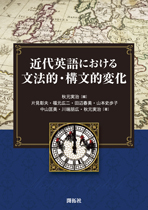
『近代英語における文法的・構文的変化』が,6月に開拓社より出版されています.15--20世紀の英文法およびその変化が実証的に記述されています.本書のユニークな点は,6名の研究者の各々が各世紀の言語事情を定点観測的に調査していることです.個々の章を読むのもよいですし,ある項目に注目して章をまたいで読むのもよいと思います.
本書については,本ブログ,Voicy heldio,YouTube で様々にご紹介してきました.昨日の heldio では川端朋広先生(愛知大学)との対談回の第2弾「#831. 『近代英語における文法的・構文的変化』 --- 川端朋広先生との対談 (2)」を配信しました.今回は,現代英語の言語変化を研究する際の難しさ,悩み,魅力などに注目し,最終的には研究法をめぐる談義に発展しました.35分ほどの音声となります.お時間のあるときにどうぞ.
こちらの回をもって,本書紹介シリーズが出そろったことになります.改めてこれまでの関連コンテンツへのリンクを張っておきます.著者の先生方の声を聴きつつ本書を読んでいくというのも,一つの味わい方かと思います.
・ YouTube 「井上逸兵・堀田隆一英語学言語学チャンネル」より「#137. 辞書も規範文法も18世紀の産業革命富豪が背景に---故山本史歩子さん(英語・英語史研究者)に捧ぐ---」
・ hellog 「#5166. 秋元実治(編)『近代英語における文法的・構文的変化』(開拓社,2023年)」 ([2023-06-19-1])
・ hellog 「#5167. なぜ18世紀に規範文法が流行ったのですか?」 ([2023-06-20-1])
・ hellog 「#5182. 大補文推移の反対?」 ([2023-07-05-1])
・ hellog 「#5186. Voicy heldio に秋元実治先生が登場 --- 新刊『近代英語における文法的・構文的変化』についてお話しをうかがいました」 ([2023-07-09-1])
・ hellog 「#5208. 田辺春美先生と17世紀の英文法について対談しました」 ([2023-07-31-1])
・ hellog 「#5224. 中山匡美先生と19世紀の英文法について対談しました」 ([2023-08-16-1])
・ hellog 「#5235. 片見彰夫先生と15世紀の英文法について対談しました」 ([2023-08-27-1])
・ hellog 「#5242. 川端朋広先生と20世紀の英文法について対談しました」 ([2023-09-03-1])
・ hellog 「#5249. 川端朋広先生と現代英語の言語変化をいかに研究するかについて対談しました」 ([2023-09-09-1])
・ heldio 「#769. 『近代英語における文法的・構文的変化』 --- 秋元実治先生との対談」
・ heldio 「#772. 『近代英語における文法的・構文的変化』 --- 16世紀の英語をめぐる福元広二先生との対談」
・ heldio 「#790. 『近代英語における文法的・構文的変化』 --- 田辺春美先生との対談」
・ heldio 「#806. 『近代英語における文法的・構文的変化』 --- 中山匡美先生との対談」
・ heldio 「#824. 『近代英語における文法的・構文的変化』 --- 川端朋広先生との対談 (1)」
・ heldio 「#831. 『近代英語における文法的・構文的変化』 --- 川端朋広先生との対談 (2)」
・ heldio 「#837. 18世紀の英語の文法変化 --- 秋元実治先生との対談」(←こちらは 2023/09/15(Fri) の後記)
・ 秋元 実治(編),片見 彰夫・福元 広二・田辺 春美・山本 史歩子・中山 匡美・川端 朋広・秋元 実治(著) 『近代英語における文法的・構文的変化』 開拓社,2023年.
2023-08-19 Sat
■ #5227. 古英語の名前研究のための原資料 [oe][anglo-saxon][onomastics][evidence][philology][methodology][name_project][domesday_book]
連日の記事「#5225. アングロサクソン人名の構成要素 (2)」 ([2023-08-17-1]),「#5226. アングロサクソン人名の名付けの背景にある2つの動機づけ」 ([2023-08-18-1]) で引用・参照してきた Clark (453) より,そもそも古英語の名前研究 (onomastics) の原資料 (source-materials) にはどのようなものがあるのかを確認しておきたい.
The sources for early name-forms, of people and of places alike, are, in terms of the conventional disciplines, ones more often associated with 'History' than with 'English Studies': they range from chronicles through Latinised administrative records to inscriptions, monumental and other. Not only that: the aims and therefore also the findings of name-study are at least as often oriented towards socio-cultural or politico-economic history as towards linguistics. This all goes to emphasise how artificial the conventional distinctions are between the various fields of study.
Thus, onomastic sources for the OE period include: chronicles, Latin and vernacular; libri vitae; inscriptions and coin-legends; charters, wills, writs and other business-records; and above all Domesday Book. Not only each type of source but each individual piece demands separate evaluation.
伝統的な古英語の文献学的研究とは少々異なる視点が認められ,興味深い.とはいえ,文献学的研究から大きく外れているわけでもない.文献学でも引用内で列挙されている原資料はいずれも重要なものだし,引用の最後にあるように "each individual piece" の価値を探るという点も共通する.ただし,固有名は一般の単語よりも同定が難しいため,余計に慎重を要するという事情はありそうだ.
原資料をめぐる問題については以下の記事を参照.
・ 「#1264. 歴史言語学の限界と,その克服への道」 ([2012-10-12-1])
・ 「#2865. 生き残りやすい言語証拠,消えやすい言語証拠――化石生成学からのヒント」 ([2017-03-01-1])
・ 「#1051. 英語史研究の対象となる資料 (1)」 ([2012-03-13-1])
・ 「#1052. 英語史研究の対象となる資料 (2)」 ([2012-03-14-1])
・ Clark, Cecily. "Onomastics." The Cambridge History of the English Language. Vol. 1. Ed. Richard M. Hogg. Cambridge: CUP, 1992. 452--89.
2023-08-04 Fri
■ #5212. 地名学者はなぜフィールドワークをするのか? [onomastics][toponymy][methodology]
地名学者 (toponymist) は机に向かって研究することが多いという.昨今は Google Earth や3次元モデリングの地図ソフトなどを利用するコンピュータ上の作業も多くなっているようだ.一方,フィールドワークという実地検分も欠かせないという.
スコットランドの地名を研究している Simon Taylor という地名学者が,固有名詞学に関するハンドブックのなかの1節で,フィールドワークについて次のように書いている.地名学者の生態が垣間見える良い話しだなと思ったので引用しておきたい.
There is much in the life and work of the toponymist which involves sitting at a desk, whether at home, in a library, or in an archive. Equally, there are aspects essential to the work which involve 'getting out and about'; for the purposes not just of interrogating those who live in a landscape, as in the collection of oral material, but of interrogating the landscape itself. There are many cases in which the landscape offers the key to the interpretation of a name. Ambiguity and doubt abound especially in the interpretation of names which have been mediated by a language or languages different from the one in which they were originally coined, and it is often only a careful consideration of the physical landscape, past and present, which can offer any chance of certainty. While some of this can be done through maps, and with the recently available online resources such as Google Earth and the 3D modelling of maps in such programs as Fugawi UK, there is, for the foreseeable future at least, no substitute for being in and moving through the actual landscape.
Even in cases in which there is little or no doubt concerning a given element, a detailed engagement with the landscape can shed much light on the precise definition and application of the element involved, bringing us closer to the mindset and motivations of the original name-givers. (Taylor 75)
なるほど,時間は隔たっているとしても,空間を共有すれば,かつての名付けの動機つけなどについて何かインスピレーションを得られるかもしれないということなのだろう.これは,歴史に関連する分野であれば,地名に限らずどんな対象についても言えることかもしれない.昨今は家にいながらにしてできることが増えてきたのも確かだが,そんなことばかり言っていないで外に繰り出そう!
・ Taylor, Simon. "Methodologies in Place-name Research." Chapter 5 of The Oxford Handbook of Names and Naming. Ed. Carole Hough. Oxford: OUP, 2016. 69--86.
2023-02-11 Sat
■ #5038. 語用論の学際性 [pragmatics][linguistics][sociolinguistics][philosophy_of_language][psycholinguistics][ethnography_of_speaking][anthropology][politics][history_of_linguistics][methodology][toc]
「#5036. 語用論の3つの柱 --- 『語用論の基礎を理解する 改訂版』より」 ([2023-02-09-1]) で紹介した Gunter Senft (著),石崎 雅人・野呂 幾久子(訳)『語用論の基礎を理解する 改訂版』(開拓社,2022年)の序章では,語用論 (pragmatics) が学際的な分野であることが強調されている (4--5) .
このことは,語用論が「社会言語学や何々言語学」だけでなく,言語学のその他の伝統的な下位分野にとって,ヤン=オラ・オーストマン (Jan-Ola Östman) (1988: 28) が言うところの,「包括的な」機能を果たしていることを暗に意味する.Mey (1994: 3268) が述べているように,「語用論の研究課題はもっぱら意味論,統語論,音韻論の分野に限定されるというわけではない.語用論は…厳密に境界が区切られている研究領域というよりは,互いに関係する問題の集まりを定義する」.語用論は,彼らの状況,行動,文化,社会,政治の文脈に埋め込まれた言語使用者の視点から,特定の研究課題や関心に応じて様々な種類の方法論や学際的なアプローチを使い,言語とその有意味な使用について研究する学問である.
学際性の問題により我々は,1970年代が言語学において「語用論的転回」がなされた10年間であったという主張に戻ることになる.〔中略〕この学問分野の核となる諸領域を考えてみると,言語語用論は哲学,心理学,動物行動学,エスノグラフィー,社会学,政治学などの他の学問分野と関連を持つとともにそれらの学問分野にその先駆的形態があることに気づく.
本書では,語用論が言語学の中における本質的に学際的な分野であるだけでなく,社会的行動への基本的な関心を共有する人文科学の中にあるかなり広範囲の様々な分野を結びつけ,それらと相互に影響し合う「分野横断的な学問」であることが示されるであろう.この関心が「語用論の根幹は社会的行動としての言語の記述である」 (Clift et al. 2009: 509) という確信を基礎とした本書のライトモチーフの1つを構成する.
6つの隣接分野の名前が繰り返し挙げられているが,実際のところ各分野が本書の章立てに反映されている.
・ 第1章 語用論と哲学 --- われわれは言語を使用するとき,何を行い,実際に何を意味するのか(言語行為論と会話の含みの理論) ---
・ 第2章 語用論と心理学 --- 直示指示とジェスチャー ---
・ 第3章 語用論と人間行動学 --- コミュニケーション行動の生物学的基盤 ---
・ 第4章 語用論とエスノグラフィー --- 言語,文化,認知のインターフェース ---
・ 第5章 語用論と社会学 --- 日常における社会的相互行為 ---
・ 第6章 語用論と政治 --- 言語,社会階級,人種と教育,言語イデオロギー ---
言語学的語用論をもっと狭く捉える学派もあるが,著者 Senft が目指すその射程は目が回ってしまうほどに広い.
・ Senft, Gunter (著),石崎 雅人・野呂 幾久子(訳) 『語用論の基礎を理解する 改訂版』 開拓社,2022年.
2023-01-23 Mon
■ #5019. 辞書比較の前に押さえておきたいこと [dictionary][genius6][lexicography][methodology][voicy][heldio][masanyan][aokikun]
昨日の記事「#5018. khelf メンバーと4人でジェンダーとコロナ禍周りのキーワードで『ジーニアス英和辞典』の版比較 in Voicy」 ([2023-01-22-1]) で紹介しましたが,6つの版を縦に比較した Voicy 放送「#600. 『ジーニアス英和辞典』の版比較 --- 英語とジェンダーの現代史」が,嬉しいことに多く聴かれています.ちょっとした khelf(慶應英語史フォーラム)企画というつもりでの収録でしたが,辞書比較のおもしろさが伝わったようであれば嬉しいです.
今回は身近な語句で辞書の版比較を導入しておもしろさを感じていただくという趣旨でしたが,辞書の版違いを用いるという手法は,現代英語の本格的な通時的研究にも利用できます.英和辞書でも英英辞書でも,「売れ筋」系の老舗辞書であれば,おおよそ定期的に新版が出版されています.例えば老舗でポピュラーな The Concise Oxford Dictionary のシリーズ(最新は12版)を利用すれば,優に100年を超える通時的な観察が可能です.Webster 系の辞書などでは,約200年にわたる英語の記述を追いかけることもできます.私自身も複数の辞書の異なる版を比較して英語史研究を行なってきました.例えば以下の論文では,ひたすら辞書を比較しています.
・ Hotta, Ryuichi. "Thesauri or Thesauruses? A Diachronic Distribution of Plural Forms for Latin-Derived Nouns Ending in -us." Journal of the Faculty of Letters: Language, Literature and Culture 106 (2010): 117--36.
・ Hotta, Ryuichi. "Noun-Verb Stress Alternation: An Example of Continuing Lexical Diffusion in Present-Day English." Journal of the Faculty of Letters: Language, Literature and Culture 110 (2012): 39--63.
研究手法としてはシンプルで応用が利きやすいように見えますが,注意が必要です.同一シリーズの辞書であっても編纂方針が一貫しているとは限らないからです.辞書作りは,出版社によって,編纂者によって,その時々の言語学の潮流やニーズによって,記述主義と規範主義の間で揺れ動くものだからです.したがって,研究に先立って辞書批評が必要となります.そのために,研究者には辞書学や辞書の歴史に関する素養も必要となってきます.異なるシリーズの辞書を組み合わせて研究する場合には,さらに慎重な事前評価が求められるでしょう.
今回の『ジーニアス英和辞典』の版比較の heldio 放送は,あくまで導入的なものです.本格的な研究に耐える議論へ発展させようとすれば,同シリーズの辞書の textual criticism が必要となることを強調しておきたいと思います.
2023-01-22 Sun
■ #5018. khelf メンバーと4人でジェンダーとコロナ禍周りのキーワードで『ジーニアス英和辞典』の版比較 in Voicy [dictionary][genius6][gender][covid][voicy][heldio][language_change][sociolinguistics][lexicography][methodology]
昨日の Voicy 「英語の語源が身につくラジオ (heldio)」 では,khelf(慶應英語史フォーラム)の大学院生メンバー3名とともに「#600. 『ジーニアス英和辞典』の版比較 --- 英語とジェンダーの現代史」をお届けしました.ジェンダーとコロナ禍に関するキーワードについて『ジーニアス英和辞典』の初版から最新の第6版までを引き比べ,英語史を専攻する4人があれやこれやとおしゃべりしています.意外な発見が相次いで,盛り上がる回となりました.30分ほどの長さです.ぜい時間のあるときにお聴きいただければと思います.Voicy のコメント機能により,ご感想などもお寄せいただけますと嬉しいです.
今回比較した『ジーニアス英和辞典』の6つの版の出版年をまとめておきます.5--8年刻みで,おおよそ定期的に出版されており,1つのシリーズ辞典で英語の記述を通時的に追いかけることが可能となっています.
| 版 | 出版年 |
|---|---|
| G1 | 1987年 |
| G2 | 1993年 |
| G3 | 2001年 |
| G4 | 2006年 |
| G5 | 2014年 |
| G6 | 2022年 |
昨年11月に発売開始となった最新版の『ジーニアス英和辞典』第6版については,hellog および heldio で何度か取り上げてきました.以下をご参照ください.
・ hellog 「#4892. 今秋出版予定の『ジーニアス英和辞典』第6版の新設コラム「英語史Q&A」の紹介」 ([2022-09-18-1])
・ hellog 「#4950. 最近の英語の変化のうねり --- 『ジーニアス英和辞典』第6版のまえがきより」 ([2022-11-15-1])
・ hellog 「#4975. 2重目的語を取る動詞,取りそうで取らない動詞」 ([2022-12-10-1])
・ heldio 「#532. 『ジーニアス英和辞典』第6版の出版記念に「英語史Q&A」コラムより spring の話しをします」
・ heldio 「#557. まさにゃん対談:supply A with B の with って要りますか? --- 『ジーニアス英和辞典』新旧版の比較」
Powered by WinChalow1.0rc4 based on chalow